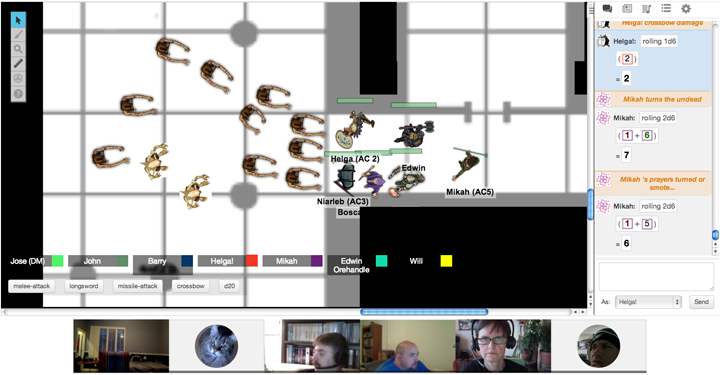Difference between revisions of "OSR"
From Roll20 Wiki
| Line 24: | Line 24: | ||
'''Turn Tracker:''' | '''Turn Tracker:''' | ||
Turn Tracker won't work unless you have Tokens. Once you enable a player to control a token and turn on your Turn Tracker, the players can enter in their initiative roll results into the Turn Tracker interface. Then it's just a matter of clicking the arrow when it's the next player/monsters turn. [[Turn_Tracker|https://wiki.roll20.net/Turn_Tracker]] | Turn Tracker won't work unless you have Tokens. Once you enable a player to control a token and turn on your Turn Tracker, the players can enter in their initiative roll results into the Turn Tracker interface. Then it's just a matter of clicking the arrow when it's the next player/monsters turn. [[Turn_Tracker|https://wiki.roll20.net/Turn_Tracker]] | ||
| + | |||
| + | '''Other Resources:'''<br /> | ||
| + | [https://drive.google.com/previewtemplate?id=1xR6wUldWjUyFKP_12PosJHtqQ4baLqaIc3vIitflp5s&mode=public# OSR Character Sheet Template for Google Docs] | ||
| + | |||
| + | ''Example of OSR gameplay on Roll20.net with the classic dungeon crawl "Stonehell".'' | ||
| + | |||
| + | [[File:OSR-gameplay.png|The classic dungeon crawl "Stonehell" on Roll20.net]] | ||
[[category:Guides]] | [[category:Guides]] | ||
Revision as of 05:01, 3 May 2013
OSRIC
Old School Revival games like Basic Fantasy, Labyrinth Lord & Swords and Wizardry are a breeze to set up in Roll20.
The Basics:
Map: Many maps in OSR games are simple black and white drawings. I find uploading as a PNG file works best. Be sure to use the map grid alignment tool to scale your map: https://wiki.roll20.net/Aligning_Maps
Tokens: I like to get all my player and monster tokens on the map before the game starts. I simply put them on the GM layer and reveal them to the Token layer when I'd like the players to see them. See Moving Objects Between Layers https://wiki.roll20.net/Layers
Dice: Most OSR games use pretty simple dice mechanics the Dice Rolling GUI works great. Game play goes very smooth once your players get used to using that interface. https://wiki.roll20.net/Dice_Rolling_GUI
You could play with just what's listed above, but lets go into some more advanced features:
Hiding and Revealing the Map: Of course you might want to hide your map from the players. If you want a real old school flavor you could keep your map on the GM Layer and simply use the drawing tool on the Map layer as you go…. but that can be pretty cumbersome with a mouse. I prefer loading the map on the map layer and using the Fog of War tool to reveal areas to the players: https://wiki.roll20.net/Fog_of_War
Tokens Features: Characters in OSR games have simple stats and abilities in general so it's not too hard to incorporate some advance Roll20.net features. A Token with just a health bar is easy to set up by simply giving the player control of the token and making sure they can see and edit the "Name" and "Bar 1". Don't forget to check "Show nameplate?" button as well. https://wiki.roll20.net/Token_Features
Turn Tracker: Turn Tracker won't work unless you have Tokens. Once you enable a player to control a token and turn on your Turn Tracker, the players can enter in their initiative roll results into the Turn Tracker interface. Then it's just a matter of clicking the arrow when it's the next player/monsters turn. https://wiki.roll20.net/Turn_Tracker
Other Resources:
OSR Character Sheet Template for Google Docs
Example of OSR gameplay on Roll20.net with the classic dungeon crawl "Stonehell".










